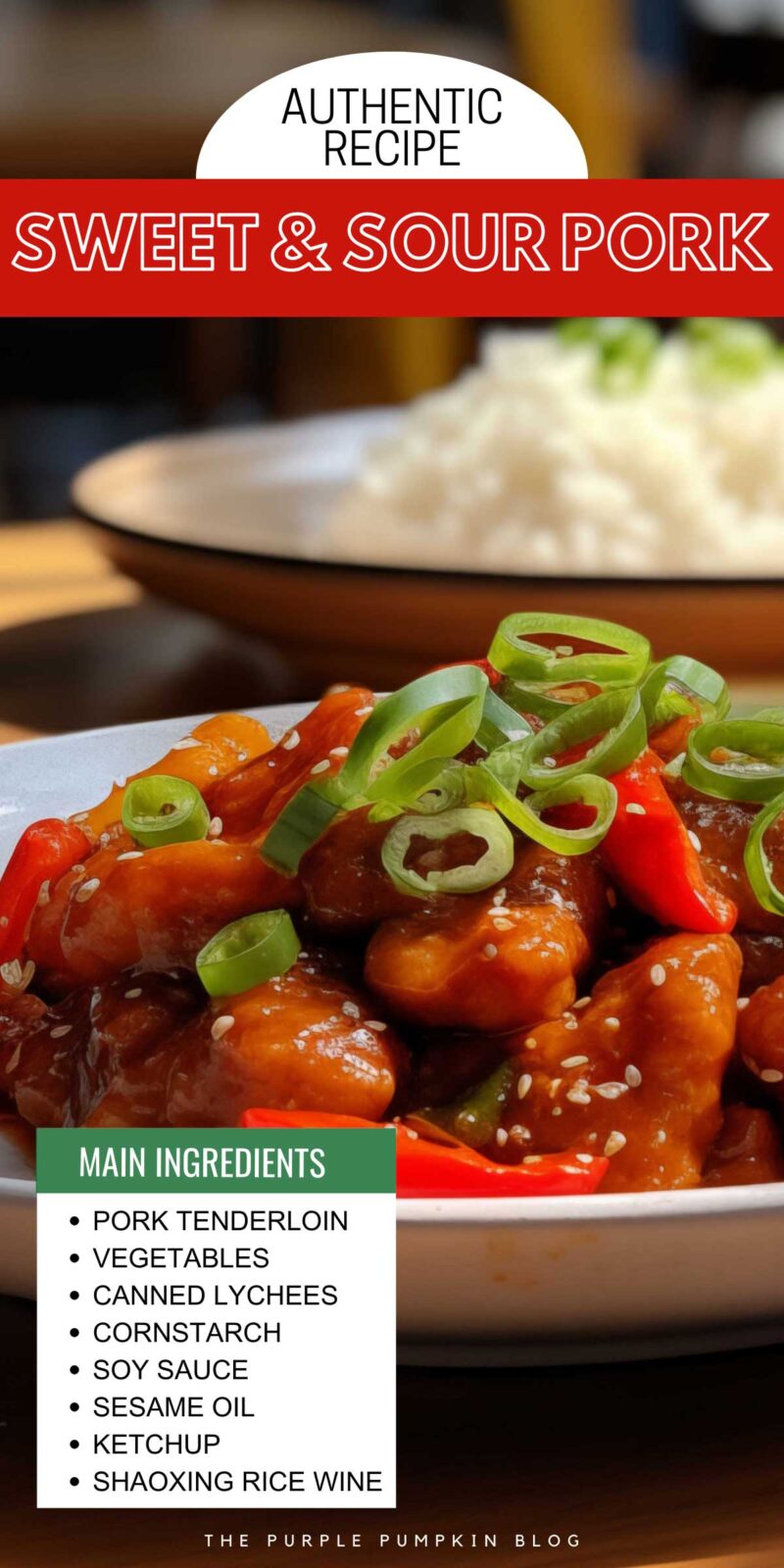Chinese Sweet and Sour Pork Recipe (Easy to Make!)
Home » COOK » Recipes » Holiday Recipes » Chinese New Year Recipes »Dive into the tantalizing world of Chinese cuisine with our Sweet and Sour Pork Recipe, a dish that promises to delight your taste buds and add a dash of excitement to your dining table!
Sweet and sour pork is a beloved classic found in Chinese restaurants, boasting a delicious blend of succulent pork and crispy vegetables in a tangy sauce.
Whether for a cozy family dinner or a festive occasion, this colorful dish is a feast for both the eyes and the palate!
Don’t have time for this recipe now? Tap the share icon in the bottom right of the screen, then tap the heart icon ♥ to save it for later!
Affiliate Disclosure
We have included affiliate links to products and services related to the topic of this post.
This post contains affiliate links, and we will be compensated if you purchase after clicking on those links.
As an Amazon Associate, I earn from qualifying purchases.
Read Our Full Disclosure and Privacy Policy
While you may prefer to skip to the recipe card, we suggest reading the entire blog post to avoid missing valuable tips and substitution suggestions and to ensure you have the necessary ingredients, equipment, and understanding of the steps and timings.
Chinese Sweet and Sour Pork Recipe
We first shared this sweet and sour recipe back in 2012 for our Year of the Dragon Chinese Banquet.
It is one of the most popular Chinese dishes here in the UK, often made Hong Kong style with pieces of pork fried in a thick batter and served in a bright red sauce (created using food dye).
In the USA, Sweet and Sour Chicken is the popular take out option—the sweet sauce works well with both types of meat, as well as with shrimp or prawns.
Chinese cooking has spread across the world, and as well as there being variations from country to country, there are regional variations within China itself.

Our homemade version, inspired by the famous Chinese chef Ken Hom, is a Southern China recipe that has a unique twist using lychees instead of pineapple chunks.
In this recipe, the tender pork has a crispy coating made with a light batter of cornstarch and egg rather than the thick batter popular in the UK.
We have made this dish with and without batter, and it is equally delicious both ways. We’ve included how to cook this recipe without deep-frying the pork.
Serve sweet and sour pork with noodles or steamed white rice, Shrimp Fried Rice Recipe, or even Cauliflower Fried Rice. Or pair it with other Chinese Recipes to create a feast!
How To Make Sweet and Sour Pork
If you want the quick printable recipe card, scroll to the bottom of this post to print it out. But for all the tips, keep reading!
Number of Servings: 4
Prep: 15 mins | Cook: 15 mins | Marinading: 30 mins | Total: 60 mins
Step 1 – Gather Your Ingredients
The ingredients and tools in this recipe are conveniently linked to online retailers like Amazon or Amazon Fresh.
- Pork Tenderloin – You want to use a lean cut of pork, such as pork loin steaks, for this recipe as it cooks quickly. You could also use chicken or shrimp/prawns, which work well with the vibrant sauce.
- Fresh Ingredients – Red Bell Pepper, Yellow Bell Pepper (but you can use any color bell peppers you like), carrots, spring onions (green onions/scallions).
- Shaoxing Rice Wine – You may find this in your local supermarket, and you will definitely find this in Asian grocery stores—it is a key ingredient in many Chinese recipes! It’s what gives Chinese food its distinctive flavor.
- It is named after its city of origin—Shaoxing—and is one of China’s oldest and most popular rice wines.
- Rice wine is alcoholic, so if this is a concern for you, you can leave it out, but this will affect the flavor profile of your homemade dumplings. Replace it with some chicken stock/broth.
- If you are unable to source Shaoxing rice wine, you can substitute it with dry sherry, Japanese Mirin, or cooking sake.
- Light Soy Sauce
- Dark Soy Sauce
- Sesame Oil
- Chinese White Rice Vinegar – This can be substituted for Apple Cider Vinegar.
- Sea Salt
- Ground White Pepper – A quintessential spice in Chinese recipes. It has an earthier, spicier flavor than black pepper. Do not substitute white pepper for Black Pepper unless you really have to!
- Sugar
- Cornstarch – Also known as Cornflour, is used to thicken the sweet homemade sauce
- Chicken Broth/Stock
- Tomato Paste – Also known as Tomato Purée. You can also use Ketchup for a sweeter sauce.
- Canned Lychees – You could also use fresh orange segments or canned pineapple chunks if desired.
- Groundnut Oil – Also known as peanut oil, and used for deep frying the marinated pork in this recipe.
- If allergies are a concern for you, or you can’t source this oil (another common ingredient used in Asian cuisine), you can use another type of neutral oil, such as canola, sunflower, or vegetable oil.
- Do not get this confused with sesame oil, which is for dressing food rather than cooking with it.
The complete list of ingredients with measurements is on the recipe card at the end of this post.
No time to read now? Tap the buttons below to save the recipe to your Pinterest boards or Facebook page for later!
Step 2 – Kitchen Tools
- Sharp Knife
- Chopping/Cutting Board
- Mixing Bowls
- Small Saucepan – For part-cooking the carrots.
- Large Wok – You can use a Large Skillet or Nonstick Frying Pan
- Large, Deep Saucepan – For deep-frying. Or you could use a Stand-alone Deep Fryer Unit.
- Spider Strainer/Slotted Spoon – For lifting the cooked spring rolls from the hot oil.
- Kitchen Paper Towels – for absorbing excess oil after frying.
The Purple Pumpkin Blog uses both cups and weighted measurements in its recipes, making American cups and kitchen food scales valuable tools for trying all the recipes. We provide US customary, imperial, and metric measurements. Still, it’s important to note that while you can combine cup measurements with weighted measures, never mix US customary/imperial (pounds, ounces, pints, etc.) with metric (kilograms, grams, liters, etc.).
Step 3 – Marinade Pork
Cut pork into 1″/2.5 cm cubes and place into a medium bowl with the marinade ingredients—Shaoxing rice wine, light soy sauce, sesame oil, and one teaspoon salt. Leave to marinate for 30 minutes.
TIP! You can leave the pork to marinade for up to 24 hours.
Step 4 – Prepare Vegetables
Meanwhile, cut the bell peppers into 1″/2.5 cm squares and cut the spring onions into 1″/2.5 cm pieces. Peel and cut the carrots into 1″/2.5 cm pieces and cook in a small pan of boiling water for 4 minutes. Drain and set aside.
TIP! For even cooking and harmony within the dish, make sure your vegetables and your pork are similar sized pieces.
Step 5 – Prepare Batter
Whisk the egg and cornstarch in a large bowl until well combined into a light batter. Set it aside.
Step 7 – Heat Oil for Deep-Frying
Pour the groundnut oil into a deep saucepan (or use your deep-fat fryer) and heat to 180°/350°F.
TIP! Use a food thermometer to check the temperature of the oil. If you do not have one, you can test if the oil is hot enough by dropping a cube of bread into it. If it turns golden in 15 seconds and floats on the surface, it is hot enough to fry.
Step 8 – Deep Fry Pork
Lift the cubes of pork out of the marinade, leaving the marinade behind, and place them into the batter, coating each piece well. Working in batches, gently place into the hot oil and fry for 4-5 minutes until cooked and golden brown. Drain the fried pork pieces on a plate lined with a kitchen paper towel and keep warm. Continue frying until all the pork is cooked.
TIP! You may have to bring the oil back up to temperature between batches.
Step 8 – Make Cornstarch Slurry
In a small bowl, stir two teaspoons of cornflour with one tablespoon of cold water and set aside.
Step 9 – Make Sweet and Sour Sauce
In a bowl, combine the chicken stock, dark soy sauce, light soy sauce, sesame oil, rice wine vinegar, sugar, tomato puree (or ketchup), salt, and white pepper. Place into a hot work and bring to a boil.
Step 10 – Finish Dish
Add the vegetables to the sauce, stir well, then stir in the slurry. Bring the sauce back to a boil, then lower the heat to a simmer.
Add the lychees (oranges or pineapple) and the crispy pork. Mix well to combine all the ingredients, then transfer to a serving platter. Serve immediately with steamed rice or noodles.

Sweet and Sour Pork Stir Fry (Alternative Option)
If you don’t want to deep fry your meat, try our stir-fry sweet and sour pork recipe instead:
Cut the pork into thin strips instead of cubes, marinate as in the recipe, and cut the vegetables. Add a little bit of oil to a hot wok and stir-fry the pork for 3-4 minutes until cooked, then add the vegetables and cook for a further 2-3 minutes.
Add the sauce and stir, then add the slurry to thicken. Serve as desired on a bed of rice or noodles.

Storing Leftovers & Freezing
- Storing Leftovers:
- Cool (within 1-2 hours), transfer to an airtight container, and store in the fridge for up to 3 days.
- Reheat until piping hot throughout.
- With all leftovers, ensure the food looks and smells okay before consuming.
- Safe Minimum Internal Temperature Chart for Cooking
- You can always consult the Food Standards Agency in your country for the most up-to-date advice on storing and freezing foods: Food Standards Agency (UK) | Food Safety (USA).
Printable Sweet and Sour Pork Recipe Card
Below is the printable recipe card. To save ink, any demonstration photos on the recipe card are not printed out.
*NEW FEATURE!* Tap the Add To Shopping List button to save the ingredients list to your phone!
We appreciate it when you review the recipe and leave a star rating to share your experience with others!

Sweet and Sour Pork
This Sweet and Sour Pork Recipe perfectly blends crispy pork, tangy sauce, and vibrant vegetables.
Ingredients
- 450g/1 lb lean pork tenderloin
- 1 Tbsp Shaoxing rice wine or dry sherry
- 1 Tbsp light soy sauce
- 2 tsps sesame oil
- 1 tsp salt
- 1 yellow bell pepper
- 1 red bell peppers
- 1 large carrot
- 3 spring onions (green onions/scallions)
- 1 egg, beaten
- 2 Tbsps cornflour (cornstarch)
- 450ml/2 cups groundnut (peanut) oil or vegetable oil for deep frying
- 80g/3 oz canned lychees, drained, or fresh orange segments
For the sauce
- 150ml/½ cup chicken stock
- 1 Tbsp light soy sauce
- 2 tsp dark soy sauce
- 2 tsp sesame oil
- 1½ Tbsps Chinese white rice vinegar or cider vinegar
- 1 Tbsp sugar
- 2 Tbsps tomato paste/purée or ketchup
- ½ tsp salt
- 1 tsp white pepper
- 2 tsps cornflour (cornstarch)
Instructions
- Cut pork into 1"/2.5 cm cubes and place into a medium bowl with the marinade ingredients—Shaoxing rice wine, light soy sauce, sesame oil, and one teaspoon salt. Leave to marinate for 30 minutes.
- Meanwhile, cut the bell peppers into 1"/2.5 cm squares and cut the spring onions into 1"/2.5 cm pieces. Peel and cut the carrots into 1"/2.5 cm pieces and cook in a small pan of boiling water for 4 minutes. Drain and set aside.
- Whisk the egg and cornstarch in a large bowl until well combined into a light batter. Set it aside.
- Pour the groundnut oil into a deep saucepan (or use your deep-fat fryer) and heat to 180°/350°F.
- Lift the cubes of pork out of the marinade, leaving the marinade behind, and place them into the batter, coating each piece well. Working in batches, gently place into the hot oil and fry for 4-5 minutes until cooked and golden brown. Drain the fried pork pieces on a plate lined with a kitchen paper towel and keep warm. Continue frying until all the pork is cooked.
- In a small bowl, stir two teaspoons of cornflour with one tablespoon of cold water and set aside.
- In a bowl, combine the chicken stock, dark soy sauce, light soy sauce, sesame oil, rice wine vinegar, sugar, tomato puree (or ketchup), salt, and white pepper. Place into a hot work and bring to a boil.
- Add the vegetables to the sauce, stir well, then stir in the slurry. Bring the sauce back to a boil, then lower the heat to a simmer. Add the lychees (oranges or pineapple) and the crispy pork. Mix well to combine all the ingredients, then transfer to a serving platter. Serve immediately with steamed rice or noodles.

Notes
- TIP! You can leave the pork to marinade for up to 24 hours.
- TIP! For even cooking and harmony within the dish, ensure your vegetables and pork are similar sized pieces.
- TIP! Use a food thermometer to check the temperature of the oil. If you do not have one, you can test if the oil is hot enough by dropping a cube of bread into it. If it turns golden in 15 seconds and floats on the surface, it is hot enough to fry.
- TIP! You may have to bring the oil back up to temperature between batches.
Recommended Products
As an Amazon Associate and member of other affiliate programs, I earn from qualifying purchases.
Nutrition Information:
Yield: 4 Serving Size: 1Amount Per Serving: Calories: 1278Total Fat: 120gSaturated Fat: 11gTrans Fat: 3gUnsaturated Fat: 103gCholesterol: 130mgSodium: 1786mgCarbohydrates: 18gFiber: 2gSugar: 9gProtein: 34g
This site uses Nutritionix to provide estimated nutrition. Nutritional information is always approximate and will depend on the quality of ingredients used and serving sizes. If you need exact calories and macros, please do your own calculations.
Dinner Party Menu Suggestions
You’ve made the main dish, but what about the rest of the courses?
Here are additional recipes to create a menu for a dinner party or special meal:
- Appetizer: Crispy Deep Fried Chinese Five Spice Shrimp
- Side Dish: Chicken Chow Mein
- Beverage: Jasmine Iced Tea
- Dessert: Toffee Banana and Toffee Apple
More Pork Recipes
Want to make more dishes using pork? Check out these recipes next:
- Cashew Pork Stir-Fry Recipe
- Chinese-Style Pulled Pork
- Sweet & Sour Pork Chops with Peppers and Fresh Pineapple
Look here for more: Pork Recipes

bericebaby
May 5, 2014 @ 11:40 am
Hun, it’s 11:39am & I’m ready for dinner!
This looks absolutely amazing – When I get the time … I will pin every single recipie from your blog and try and do them too. Gaaa I bet this tastes amazing.
Thank you for sharing
Lotte xo
Berice Baby – London Lifestyle & Kids
Fashion Blog
Michelle Ordever
May 6, 2014 @ 12:05 pm
Aww hun, thank you!! Let me know how you get on with them!!! xx